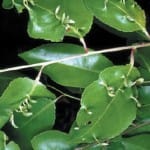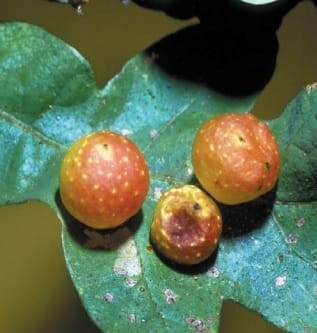These are cynipid leaf galls on an oak tree leaf
To read more about these and other insect pests on trees, read the publication Forest Health Guide for Georgia.
Galls are abnormal vegetative growths on trees that result from the feeding and egg laying activities of various insects and mites. Chemical secretions from the adults while laying eggs as well as the saliva from the feeding larvae cause the plant to react abnormally.
The more common gall producers on trees are aphids, beetles, jumping plant lice, midges, mites and wasps. Each species causes a swelling of plant tissue that is characteristic on specific plant parts such as the stem, twig, leaf or petiole. Most often the gall is more readily identified than the gall producer. It is convenient to identify galls and their producers simply by noting where the gall is located and also the shape of the gall. Table 2 on page 43 of the Forest Health Guide for Georgia lists some of the more common trees that are frequently attacked by gall producers along with a description and location of the gall.
Generally galls are not life threatening to trees. Oftentimes the most drastic effects are premature leaf fall and dieback of several smaller branches.
On small trees, galls should be pruned and destroyed. Leaf and twig litter that is on the ground around the base of the tree should be raked and disposed of. A few of the common species are shown in the images included here.
For information on galls, see page 42 of the publication Forest Health Guide for Georgia. This publication is produced by the Georgia Forestry Commission.
Other galls include:

